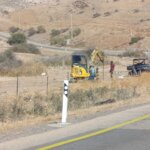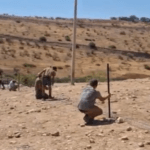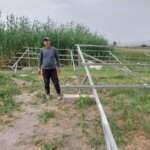Water rights
Since signing Oslo II Accord in 1995 between the Palestinian National Authority and Israel, the West Bank has been divided into three administrative Areas: A, B, and C. Area C, which the Israeli occupation authorities control, covers over 60 percent of the West Bank and is home to an estimated 180,000 – 300,000 Palestinians living in 540 communities located partially or fully in the Area. In addition, at least 235,000 Israeli settlers reside in approximately 230 illegal settlements established in the area.[1] The main legislation governing Area C of the West Bank is multi-layered, accordingly, the planning and maintenance of water structures in the West Bank is Jordan’s Towns, Villages, and Buildings Planning Law (No. 79) of 1966, also known as “the Jordanian Planning Law,” which was enacted approximately nine months before Israel occupied the West Bank. The Israeli Military Commander issued the Order Concerning Towns, Villages, and Buildings Planning Law (No. 418) (“Military Order No. 418”) in 1971, which changed the structure of the planning process and gave the Israeli Civil Administration control over the entire planning and licensing process in the West Bank. While Areas A and B were handed over to the control to the Palestinian Authority as part of the Oslo Accords and, with the exception of issues under the authority of the Joint Water Committees (JWC), are subject to Palestinian planning and water laws, the Jordanian Planning Law, as amended by Military Order No. 418, remains in effect in Area C.
[1] Palestine Hydrology Group, “The Occupation of Water,”
Jordan Valley Access to Water Resources

The Jordan Valley, of which 81% is classified as Area C, occupies a strategic position in the Palestinian context.[1] It comprises over a fifth of the territory of the West Bank and contains vital land reserves for the natural expansion of Palestinian towns and cities. It has abundant water resources – including one-third of the underground water reserves in the West Bank – and has vast potential for agricultural, industrial and tourism industries. The economic development of the Jordan Valley is considered essential for Palestinian growth and recovery and is therefore crucial for the sustainability and viability of an independent Palestinian State.[2]
Despite the abundance of water resources in Area C and the Jordan Valley, these areas suffer from acute water shortage due to the Israeli occupation policies to control water resources. Since 1967, the Israeli military authorities have been imposing complete power over all water resources and have been appropriating Palestinian land for the establishment and expansion of Israeli settlements in the area.[3] The International Humanitarian law states that due to Israel`s occupying power status in the OPT, Israel has obligations regarding the right to water. The Hague Regulations place restrictions on an occupying power’s use of private and public property, including the natural resources of the occupied territory. Article 43 of the Hague Regulations 9 imposes on an occupying power two obligations: to restore and ensure, as far as possible, public order and safety in the occupied territory, and to respect, unless absolutely prevented, the laws in force in the occupied territory.[4]
However, Israel adopts a number measures through which it can illegally exercise sovereign rights over Palestinian water resources. Thus, Israel has exerted considerable military and political efforts (1) to gain, maintain and consolidate exclusive access to Palestinian water resources, (2) to appropriate water resources for the sole benefit of Israelis, including settlers, and (3) to paralyze Palestinian water infrastructure development in the occupied Palestinian territories, aimed at forcibly transferring Palestinian communities. As such, these policies and practices have laid the foundations and underpin the three principal pillars of Israel’s ‘water-apartheid’.[5]
Comparing Water Use

Both absolutely and proportionately, Israelis use a far greater amount of the region’s total water resources. According to official Palestinian figures, Israeli settlers in the West Bank consume 10 times more water on average than the territory’s Palestinian residents. This violates Article 11(1) of the International Covenant on Economic, Social, and Cultural Rights (ICESCR), to which Israel is a state party, “the States Parties to the present Covenant recognize the right of everyone to an adequate standard of living for himself and his family, including adequate food, clothing, and housing, and to the continuous improvement of living conditions.” The Committee reaffirmed its position in 2002, in a General Comment devoted specifically to the right to water, in which it asserted that the human right to water is essential for living a dignified life[6]. Currently, West Bank Palestinians consume around 70 liters of water per capita per day, although the World Health Organization (WHO) states that a normal person requires a minimum daily water allotment of between 100 and 120 liters, to maintain the most basic standard of living. In Israel, however, daily per capita water consumption stands at some 300 liters, while Israeli illegal settlers in the West Bank consume as much as 600 liters per day. Settlements benefit from enough water to run farms and orchards, and for swimming pools and spas, while Palestinians often struggle to access the minimum water requirements.[7]
Moreover, the Palestinian population has doubled since the signing of the Oslo Accords in 1993, and the amount of water available in the West Bank — roughly 110 million cubic meters of water per year — still remains at 1995 levels. According to the accords, “the Palestinians’ water quota should have reached 200 million cubic meters by the year 2000.” [8]
The chart below shows the disparity in water use between Palestinians and Israelis

This information was collated by the Water Rights Campaign






